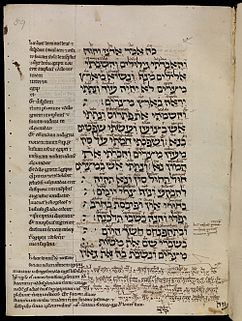| Ezekiel 16 |
|---|
|
 Book of Ezekiel 30:13–18 in an English manuscript from early 13th century, MS. Bodl. Or. 62, fol. 59a. A Latin translation appears in the margins with further interlineations above the Hebrew. |
| Book | Book of Ezekiel |
|---|
| Category | Nevi'im |
|---|
| Christian Bible part | Old Testament |
|---|
| Order in the Christian part | 26 |
|---|
Ezekiel 16 is the sixteenth chapter of the Book of Ezekiel in the Hebrew Bible or the Old Testament of the Christian Bible.[1][2] This book contains the prophecies spoken by the prophet Ezekiel, and is a part of the Book of the Prophets.[3][4] This chapter contains an image of Jerusalem as an exposed female infant, Ezekiel 16:1-5; whom God took care, Ezekiel 16:6-14, but she was not faithful, Ezekiel 16:15-34, causing God to threaten her with severe judgment, Ezekiel 16:35-43, her sin will receive punishment, Ezekiel 16:44-59, but God promises mercy in the end, Ezekiel 16:60-63.[5]
Textual versions
Some most ancient manuscripts containing this chapter in Hebrew language:
Ancient translations in Koine Greek:
Structure
NKJV groups this chapter into:
Verse 3
- And say, Thus saith the Lord God unto Jerusalem;
- Thy birth and thy nativity is of the land of Canaan;
- thy father was an Amorite, and thy mother an Hittite.[13]
This refers to "cultural and moral origins of Jerusalem" which was occupied by the Amorites and Hittites before David took it over.[14] The assimilation of Israel with those former residents led to apostasy.[15]
Verse 60
- Nevertheless I will remember my covenant with thee in the days of thy youth,
- and I will establish unto thee an everlasting covenant.[16]
Despite the disobedience and consequences, God will still honor His covenant with Abraham, as "the fulfillment of the covenant did not depend on the people's faithfulness."[14] This was anticipated in Leviticus 26:43–45.[15]
